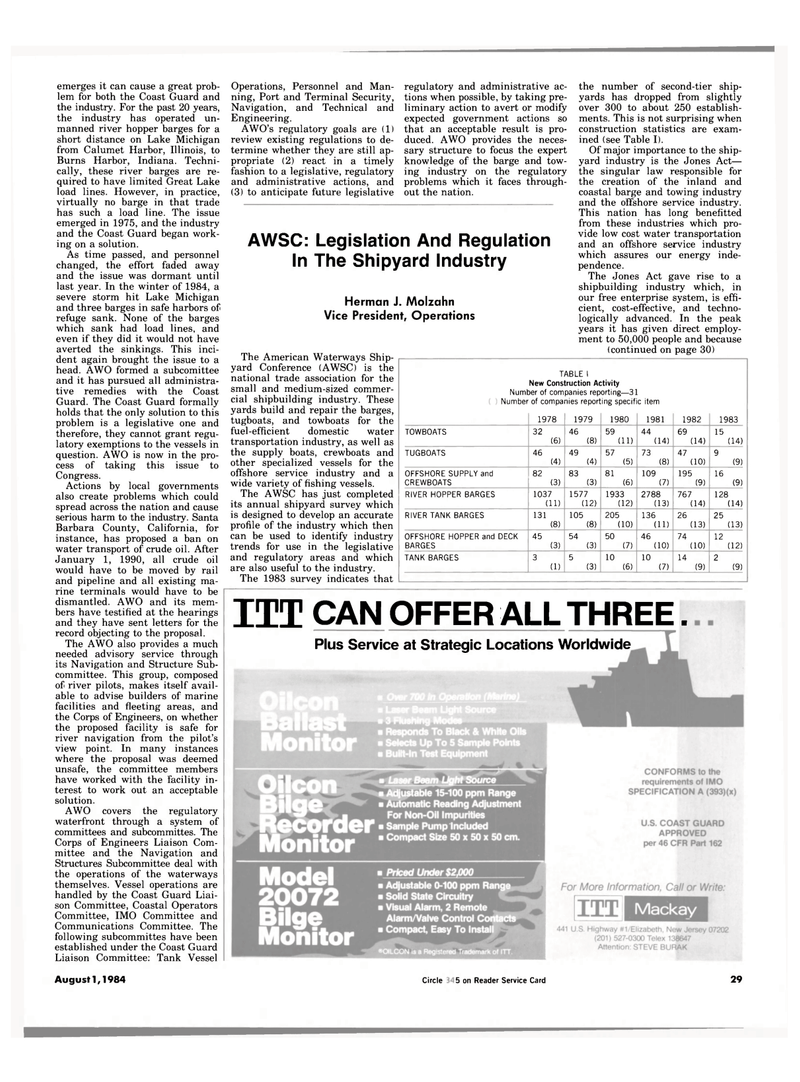
Page 27: of Maritime Reporter Magazine (August 1984)
Read this page in Pdf, Flash or Html5 edition of August 1984 Maritime Reporter Magazine
emerges it can cause a great prob- lem for both the Coast Guard and the industry. For the past 20 years, the industry has operated un- manned river hopper barges for a short distance on Lake Michigan from Calumet Harbor, Illinois, to
Burns Harbor, Indiana. Techni- cally, these river barges are re- quired to have limited Great Lake load lines. However, in practice, virtually no barge in that trade has such a load line. The issue emerged in 1975, and the industry and the Coast Guard began work- ing on a solution.
As time passed, and personnel changed, the effort faded away and the issue was dormant until last year. In the winter of 1984, a severe storm hit Lake Michigan and three barges in safe harbors of refuge sank. None of the barges which sank had load lines, and even if they did it would not have averted the sinkings. This inci- dent again brought the issue to a head. AWO formed a subcomittee and it has pursued all administra- tive remedies with the Coast
Guard. The Coast Guard formally holds that the only solution to this problem is a legislative one and therefore, they cannot grant regu- latory exemptions to the vessels in question. AWO is now in the pro- cess of taking this issue to
Congress.
Actions by local governments also create problems which could spread across the nation and cause serious harm to the industry. Santa
Barbara County, California, for instance, has proposed a ban on water transport of crude oil. After
January 1, 1990, all crude oil would have to be moved by rail and pipeline and all existing ma- rine terminals would have to be dismantled. AWO and its mem- bers have testified at the hearings and they have sent letters for the record objecting to the proposal.
The AWO also provides a much needed advisory service through its Navigation and Structure Sub- committee. This group, composed of river pilots, makes itself avail- able to advise builders of marine facilities and fleeting areas, and the Corps of Engineers, on whether the proposed facility is safe for river navigation from the pilot's view point. In many instances where the proposal was deemed unsafe, the committee members have worked with the facility in- terest to work out an acceptable solution.
AWO covers the regulatory waterfront through a system of committees and subcommittes. The
Corps of Engineers Liaison Com- mittee and the Navigation and
Structures Subcommittee deal with the operations of the waterways themselves. Vessel operations are handled by the Coast Guard Liai- son Committee, Coastal Operators
Committee, IMO Committee and
Communications Committee. The following subcommittes have been established under the Coast Guard
Liaison Committee: Tank Vessel
Operations, Personnel and Man- ning, Port and Terminal Security,
Navigation, and Technical and
Engineering.
AWO's regulatory goals are (1) review existing regulations to de- termine whether they are still ap- propriate (2) react in a timely fashion to a legislative, regulatory and administrative actions, and (3) to anticipate future legislative regulatory and administrative ac- tions when possible, by taking pre- liminary action to avert or modify expected government actions so that an acceptable result is pro- duced. AWO provides the neces- sary structure to focus the expert knowledge of the barge and tow- ing industry on the regulatory problems which it faces through- out the nation.
AWSC: Legislation And Regulation
In The Shipyard Industry
Herman J.
Vice President
The American Waterways Ship- yard Conference (AWSC) is the national trade association for the small and medium-sized commer- cial shipbuilding industry. These yards build and repair the barges, tugboats, and towboats for the fuel-efficient domestic water transportation industry, as well as the supply boats, crewboats and other specialized vessels for the offshore service industry and a wide variety of fishing vessels.
The AWSC has just completed its annual shipyard survey which is designed to develop an accurate profile of the industry which then can be used to identify industry trends for use in the legislative and regulatory areas and which are also useful to the industry.
The 1983 survey indicates that
Molzahn , Operations the number of second-tier ship- yards has dropped from slightly over 300 to about 250 establish- ments. This is not surprising when construction statistics are exam- ined (see Table I).
Of major importance to the ship- yard industry is the Jones Act— the singular law responsible for the creation of the inland and coastal barge and towing industry and the offshore service industry.
This nation has long benefitted from these industries which pro- vide low cost water transportation and an offshore service industry which assures our energy inde- pendence.
The Jones Act gave rise to a shipbuilding industry which, in our free enterprise system, is effi- cient, cost-effective, and techno- logically advanced. In the peak years it has given direct employ- ment to 50,000 people and because (continued on page 30)
TABLE I
New Construction Activity
Number of companies reporting—31
Number of companies reporting specific item 1978 1979 1980 1981 1982 1983
TOWBOATS 32 (6) 46 (8) 59 (11) 44 (14) 69 (14) 15 (14)
TUGBOATS 46 (4) 49 (4) 57 (5) 73 (8) 47 (10) 9 (9)
OFFSHORE SUPPLY and
CREWBOATS 82 (3) 83 (3) 81 (6) 109 (7) 195 (9) 16 (9)
RIVER HOPPER BARGES 1037 (11) 1577 (12) 1933 (12) 2788 (13) 767 (14) 128 (14)
RIVER TANK BARGES 131 (8) 105 (8) 205 (10) 136 (11) 26 (13) 25 (13)
OFFSHORE HOPPER and DECK
BARGES 45 (3) 54 (3) 50 (7) 46 (10) 74 (10) 12 (12)
TANK BARGES 3 (1) 5 (3) 10 (6) 10 (7) 14 (9) 2 (9)
ITT CAN OFFER ALL THREE.
Plus Service at Strategic Locations Worldwide
August 1,1984 Circle 105 on Reader Service Card 29

 26
26

 28
28
